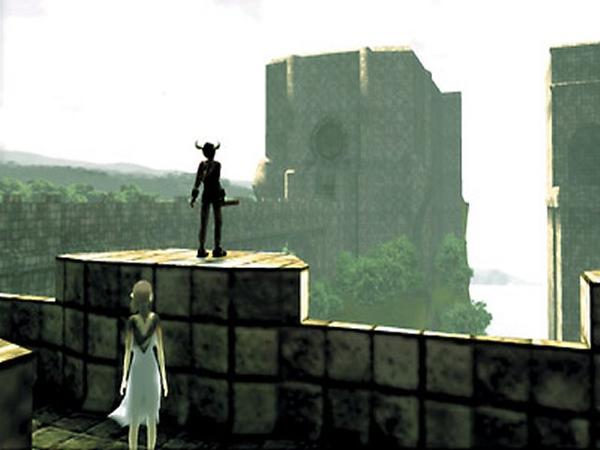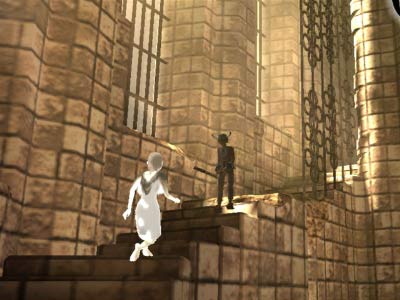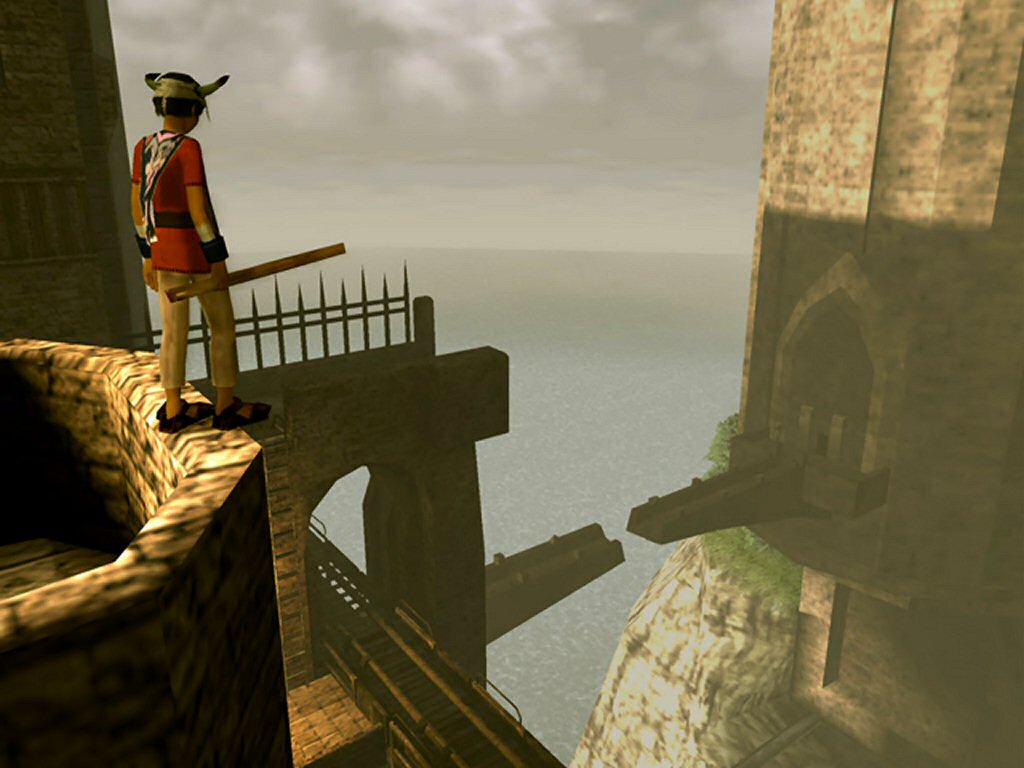Invisible Walls: Narrativizing Spatial Limitation in Ico and Assassin’s Creed II
By Bryan Wuest
Video game design includes an interesting paradox: interactivity, the ability for players to have agency and control within the game, “pretty much completely defines the game medium”1; yet normal technological limitations necessitate the curbing of player control in many ways, from limiting the range of actions a character can execute to restricting movement within the game world. This has always been a reality for game designers, but with many games’ tendency to aspire to closer and closer similarities to perceived reality, visible limitations during gameplay may be increasingly jarring interruptions to an otherwise “realistic” experience. Skillful designers are sensitive to these limitations and attempt to make them less disruptive2; for example, they work to find ways to embed necessary limitation on movement into the very narrative and/or design of the game. I’d like to suggest possible differences in player perception of spatial limitations between 2-D side-scrollers, abstract games, and games set in 3-D game spaces, as well as explore what I see as two 3-D games’ successful narrativization of spatial limitation: Assassin’s Creed II (2009) and Ico (2001). By this I mean that the necessary or imposed limitations occur in the game in a way that is coherent with (or invisible within) the narrative or gameplay, rather than visibly and disruptively introducing nondiegetic artifice into an otherwise realistic simulation.
I would argue that in a 2-D side-scroller or abstract game, spatial limitation causes less cognitive conflict. In side-scrollers, the way in which the game’s world is represented to us differs quite distinctly from the way in which we experience reality: we see the character over which we have agency move around in a frame, instead of seeing a more subjective, first-person view of the world tied more closely to the positioning of our agent. Because this kind of visual interface differs greatly from our experience of reality, we may find unrealistic spatial limitation within these interfaces less jarring. Additionally, in a side-scroller the player often has a relatively clear geographical goal: move from the left to the right. The tendency of rightward journeys in side-scrollers is so prevalent that a player may simply accept it as a rule of this world, and in a situation where less-than-reality is expected anyway (based on an unrealistic side-view interface), there is less feeling that one is being controlled in an artificial way.

From top-left, going clockwise: Kirby's Dreamland (Nintendo Gameboy, 1992); Contra (NES, 1988); Super Mario World (Super Nintendo, 1990); Sonic the Hedgehog 2 (Sega Genesis,1992)
Side-scrollers often do still have some visual resemblance to reality; although they contain two-dimensional worlds that the player views from the side, these environments are often filled with pseudo-realistic scenery, objects, and anthropomorphized characters. Abstract games, on the other hand, often deviate from representing reality even more. For example, in Tetris (1989) for the NES, the game world is highly dissimilar to reality: we control tetraminoes as they drift slowly downward in an unidentified black space, there are no live characters to control, and there is an absence of any actions like walking, jumping, or climbing that would relate game actions to physical acts of the real world. The simple core mechanic is manipulating blocks into rows with no visible or implied connection between the motion of the blocks and the actions of a live in-game agent (such as an onscreen hand turning the pieces), which creates an even more distinct gap between game and the player’s reality. Speaking broadly, an abstract game like Tetris is less a representation of a relatable reality and more a formal situation meant to focus on closed gameplay instead of narrative and characters.
Games in which a character moves in three-dimensional spaces can create a different set of expectations and problems. Here the game world is represented in a way more similar to how players perceive reality than is the case in side-scrollers or abstract games and, as such, players may have expanded expectations on the degree of freedom and control that will be offered to them in this game world. However, these games still have the same limitations: software still contends with finite memory capacity and so can only provide limited meaningful game space for the player to inhabit. In games like Super Mario 64 (1996) and Banjo-Kazooie (1998) where the player has extreme mobility through the power of flight, designers simply placed invisible walls at the edges of the game worlds. Obviously, smashing into these walls midflight immediately calls attention to the imposed limitations on player movement and negatively affects viewer immersion in the game by highlighting the artificiality of the game world.
Many other early games for Nintendo 64 made the edges of the game world inaccessible by surrounding the in-bounds area with an abyss, lava, mountains or some other diegetic barrier to movement. While this is a functional solution, I want to look more closely at two games that design these unavoidable spatial limitations into the gameplay in ways that enhance the game’s narrative. In Assassin’s Creed II, Desmond Miles must access and relive the memories of his ancestor, Ezio, in order to develop important assassin skills and recover a mystic artifact. With Ezio as his avatar, Desmond explores fifteenth-century Italy – or to be more exact, a computer rendition of the fifteenth-century constructed from his ancestor’s memories and made “real” by the Animus machine that Desmond is hooked into. When connected to the Animus, Desmond experiences his “genetic memories” through the eyes of Ezio as though he were personally living them himself. Due to this immersive world, players might find themselves forgetting that, in terms of the game diegesis, they are “actually” playing within an artificial world of Desmond’s genetic memories in present day, instead of just playing as Ezio in a game set in the fifteenth century. In short, it’s often easy to forget the present day game world exists.
The fifteenth-century game world is vast, encompassing several cities and the Italian countryside. The cities themselves are extremely dense locations, and much of the gameplay is spent navigating the cities by exploring their alleys and passageways or climbing buildings and leaping from roof to roof - a sort of Renaissance-era parkour. The ability to traverse the city by way of its rooftops is one of the most rewarding experiential aspects of the game; relatively simple controls allow even a beginner player to execute impressive-looking moves that are both aesthetically pleasing and efficient in terms of maneuvering the game world.
In a game that offers so much pleasure potential in this free movement and exploration, suddenly coming up against an invisible wall would significantly interrupt the flow state this smooth and exhilarating gameplay mechanic creates.3 Thus the game employs a technique that diegetically limits what areas of the world the player can enter at any one time. Areas are off-limits in this game for two reasons: either Desmond hasn’t “synched” with this section of the map (used to limit Ezio’s initial mobility near the beginning of the game), or the player is currently in a “memory,” something akin to a level, and the area the player is trying to enter is not part of Ezio’s experience. When Ezio enters an area that is off-limits, the visual representation of the world starts to change, glowing white and beginning to show the grid-like structure that appears on loading scenes when Desmond is plugging into different parts of his genetic memory. A text warning appears on screen, explaining that Ezio will “unsynch” if he enters this area, which is like “dying” in this game – Desmond’s link to Ezio is broken and the player must restart at the last save point.
This technique of limiting player movement is both efficient and effective. First, the enforcement of limitations are entirely encapsulated by the narrative: the player is explicitly aware that this fifteenth-century Italy is a computer rendition of Desmond’s genetic memories, and some visual details implicitly express that the world Desmond (via the Ezio avatar) is exploring is computer-constructed, such as occasional “world-building” animations where players see the visual representation of Florence form in a style that suggests a computer rendering a model.4 The unsychronization that occurs upon leaving the area allowed by the current memory also has in-game precedent: if the Desmond-controlled Ezio is killed, or kills too many bystanders, or in any way deviates too far from the memories as Ezio lived and created them, Desmond become unsynched, as it is important to the game goals that he accurately relives Ezio’s experiences. Thus if the player attempts to leave the city while playing a memory that occurred entirely within the city, it makes narrative sense that Desmond would unsynch – there would simply be no information available for the Animus machine to render the world outside the city at this moment, as Ezio lived and created the memory within the city in 1476.
Second, the enforcement of limitations actually serves to immerse the player more deeply into the game. The examples described above of the visual details that demonstrate that the world is a computer rendition, depending on how one plays the game, can actually occur quite rarely; if a skillful player makes few fatal mistakes and as such avoids unsynching, then a world-building or synching animation will be triggered rather infrequently, usually between major chapters of the game, and the player is allowed to become and immersed in the beautiful and vast representation of fifteenth-century Italy. Thus small details such as reaching the boundary of (the computer’s rendition of) a specific memory or occasional screen flickers remind the player that this world is not the game’s “real” world, and that Desmond is actually lying down attached to the Animus machine, not wandering through Florence. This reminder can serve to increase the significance of the Italy gameplay by reminding the player that there is a sort of supernarrative, based in the game’s “real” world, that Desmond’s goals in the “virtual” world of Italy relate to. It’s interesting that by emphasizing the artifice of the in-game Animus simulation of Italy, the narrative could deepen the player’s immersion in the computer simulation that is Assassin’s Creed II, a game burned onto an Xbox 360, PS3, or PC game disc.
In Ico the player controls the titular character as he tries to escape an enormous, mostly-deserted castle in which he was left for unknown reasons. His only companion is a girl named Yorda, also a prisoner of the castle. Occasionally monsters appear that Ico must defeat in order to protect Yorda, but the majority of the gameplay consists of puzzle-solving as Ico and Yorda work together in order to open passages and maneuver through the castle’s layout towards escape.
The means by which Ico and Yorda’s movement is limited are the castle walls themselves. This statement seems obvious; the children are trapped in the castle and must operate within the borders of its high stone walls until they can open the main gate. However, this feature actually exhibits an elegant combination of narrative and programming necessity. Ico takes full advantage of the spatial limitations and uses them to enhance the narrative: as a story based on a need to escape, boundaries on player movement are limited by the same walls that function narratively to keep the children trapped and motivate their exploration and escape of the castle. The player can’t go outside the castle walls because Ico and Yorda physically cannot.



In most games, such as the above-mentioned Super Mario 64 and Banjo-Kazooie, the edges of the game world tends to be unimportant to the gameplay, rather the player is meant to explore the worlds within those boundaries to find stars, coins, puzzle pieces, and/or music notes. Although the players of Ico also operate within game boundaries (in terms of the narrative), the children’s goals are always directed outwards; they move within the castle walls in order to find a way outside of them. Although players have the choice to largely ignore a game’s narrative and focus instead purely on gameplay, players that are inclined to maintain awareness of Ico’s story while playing may find the surrounding walls a constant reminder of the children’s dilemma and their isolation from the rest of the world, which could function to make normal puzzle-solving gameplay additionally meaningful. Players who are especially inclined to test games’ limits and explore the game world past what is strictly required to move forward in the game narrative may be affected by the castle walls in yet another way – reigned in by the castle walls, their interest in escape may take on a meta-game aspect of desiring to explore, investigate, and even “break” the game design systems, subtly aligning this player’s interests in pushing the boundaries of the game world with the children’s narrative interest in escape from the castle. The castle walls both limit the player’s exploration and block the characters’ escape.
These two games are examples of design that does not simply situate a narrative into a series of core mechanics, however interesting or compelling either might be; these games harness medium limitations in order to deepen narrative engagement and add significance to gameplay. This contributes to a greater coherence in the play experience and text.
NOTES
- Warren Spector, qtd. in Katie Salen and Eric Zimmerman, Rules of Play (Cambridge: MIT Press, 2004), 57.
- Although a skillful designer may also create an experimental game that intentionally calls attention to the video game medium itself..
- Salen and Zimmerman, 338; here they employ psychologist Mihály Csíkszentminhályi’s concept of “flow.”
- In an empty white space, wireframes rise up from the ground then are quickly shaded in to resemble buildings, with occasional “flickers” in the screen as though there were a power surge or disturbance in the circuitry.


